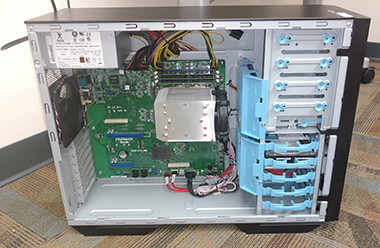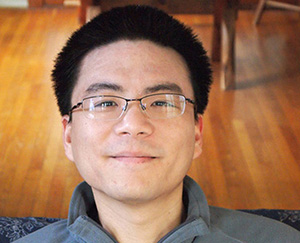Working with the Best
 |
|
The Knights Landing pilot workstation, which can simulate the interactions of millions of atoms at one time.
|
ALBANY, N.Y. (March 7, 2017) — Put two five-year-olds together in a confined space and then try to predict how they’ll behave. Challenging? Well, then try it with a few million atoms.
That’s the challenge for RNA scientists, but one made easier by the new Knights Landing (KNL) pilot workstation from Intel. Thanks to the fact that UAlbany chemist Alan Chen is doing advanced RNA research funded by the National Science Foundation (NSF), a KNL has found a temporary but critically important home in The RNA Institute.
“This is potentially a great advantage for the types of simulations my lab does, where we are trying to predict how biomolecules are going to behave and the computer has to calculate the interaction between each and every pair of atoms to predict how their positions will change over time,” said Chen, an assistant professor in Chemistry. “This would not be possible without serious supercomputing resources.”
The KNL is designed expressly for scientific computing, in that it can handle dozens of interdependent calculations all at once, as contrasted to a normal computer which can only do one calculation at a time in a first-come, first-served fashion. “It’s got 64 cores in it, which is 16 times more than a typical desktop, said Chen.
“In terms of atoms, a normal desktop would have trouble simulating more than 100,000 atoms. So far, I’ve had no problem simulating even 1,000,000 atoms on the KNL without appreciable slowdown.”
 |
|
Alan Chen of the Department of Chemistry and The RNA Institute. |
The work by Chen and his research group is related to his NSF grant, “Predicting High-Resolution RNA Tertiary Structures Using an Experimentally Calibrated Force-Field for RNA Folding”.
“The grant centers around using massive computer simulations containing millions of atoms or more to predict the 3D structures that complex biological RNA’s can adopt and then to compare it with experimental results,” said Chen. “This will be crucial for understanding how RNA architecture governs its biological functions, such as the acrobatics that viral RNA’s use to trick cells into letting them invade”.
Chen, who last year received a Faculty Early Career Development award from NSF to support a junior faculty member exemplifying excellence in teaching, research and their integration, is in the midst of a three-month effort with KNL. Part of that time will involve specialized training for his researchers, particularly where it comes to designing and optimizing scientific programs that take advantage of the special hardware.
“The loaner KNL workstation from Intel allows the researchers in my group to do hands-on testing, benchmarking, and debugging of their code to adapt it to the new KNL architecture,” he said.
The KNL, in addition to being more expensive than a standard CPU, is designed to be installed only in dedicated high performance computing centers, such as UAlbany’s state-of-the-art Data Center where the RNA Institute’s servers reside.
“It’s extremely difficult to get your hands on one of these specialty computers right now,” said Chen.
In conjunction with Chen’s NSF grant, his group was also awarded 2 million CPU hours on the STAMPEDE supercomputing resource in Texas, which is one of the world’s largest. “STAMPEDE is actually being completely replaced with KNL processors later this year, so the loaner KNL workstation gives us the opportunity to get a hands-on, sneak peak of what the whole scientific computing community will be using in the near future,” said Chen.
The access to KNL and STAMPEDE were both facilitated by the Dell Inc., a corporate backer of the RNA Institute and its main on-campus supplier for high-performance computing equipment.
![]() For more news, subscribe to UAlbany's RSS headline feeds
For more news, subscribe to UAlbany's RSS headline feeds
A comprehensive public research university, the University at Albany-SUNY offers more than 120 undergraduate majors and minors and 125 master's, doctoral and graduate certificate programs. UAlbany is a leader among all New York State colleges and universities in such diverse fields as atmospheric and environmental sciences, business, education, public health,health sciences, criminal justice, emergency preparedness, engineering and applied sciences, informatics, public administration, social welfare and sociology, taught by an extensive roster of faculty experts. It also offers expanded academic and research opportunities for students through an affiliation with Albany Law School. With a curriculum enhanced by 600 study-abroad opportunities, UAlbany launches great careers.


